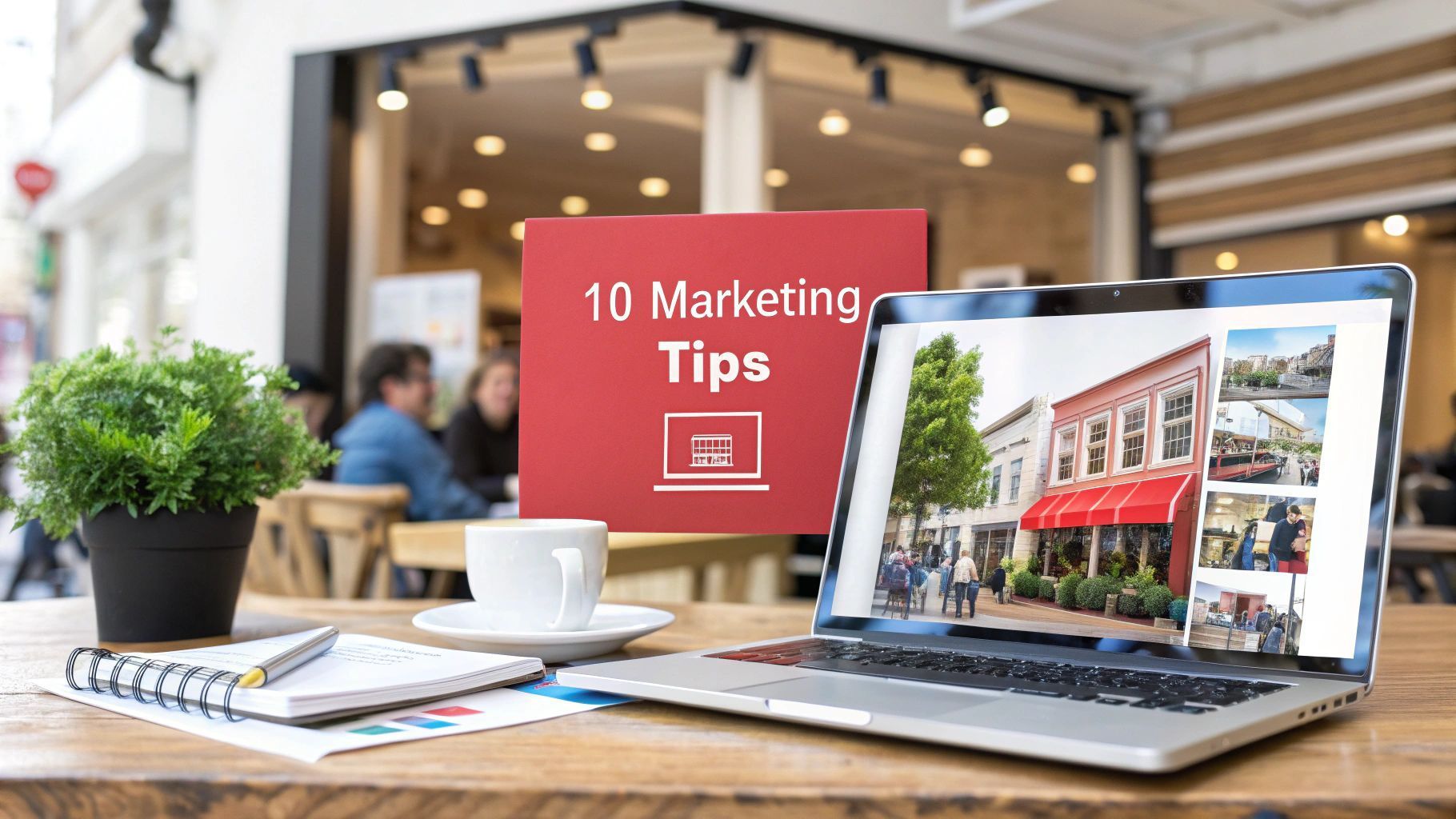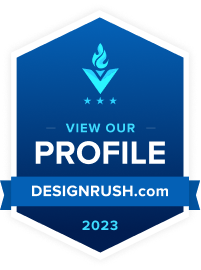Top 8 Tips for Automotive Social Media Marketing Success in 2025
In the fast-paced automotive and motorsport industries, a static showroom no longer cuts it. Today's customers live, research and connect online, making a robust social media presence non-negotiable for brand growth and lead generation. However, simply posting pictures of cars is not a strategy. Effective automotive social media marketing requires a nuanced approach that builds community, fosters trust and directly contributes to your bottom line.
This guide moves beyond generic advice to provide eight powerful, actionable strategies tailored specifically for car brands, dealerships and motorsport teams. We will break down how to implement everything from engaging user-generated content campaigns and immersive video showrooms to precision-targeted paid advertising. The focus is on practical tactics that deliver measurable results, helping you connect authentically with enthusiasts and potential buyers alike.
Whether you are a local dealership seeking more test drives or a global motorsport brand building a loyal fanbase, these insights provide the roadmap you need. To jumpstart your content creation efforts efficiently, you can even explore utilising an AI social media content generator for automotive to handle routine posts. Prepare to supercharge your digital presence and leave the competition in your rear-view mirror.
1. User-Generated Content (UGC) Campaigns
User-Generated Content (UGC) campaigns are a cornerstone of modern automotive social media marketing, transforming customers from passive consumers into active brand advocates. This strategy involves encouraging your audience to create and share their own content featuring your vehicles, dealership experiences or brand interactions. This content, ranging from photos and videos to detailed reviews, leverages authentic voices to build trust and foster a powerful sense of community.
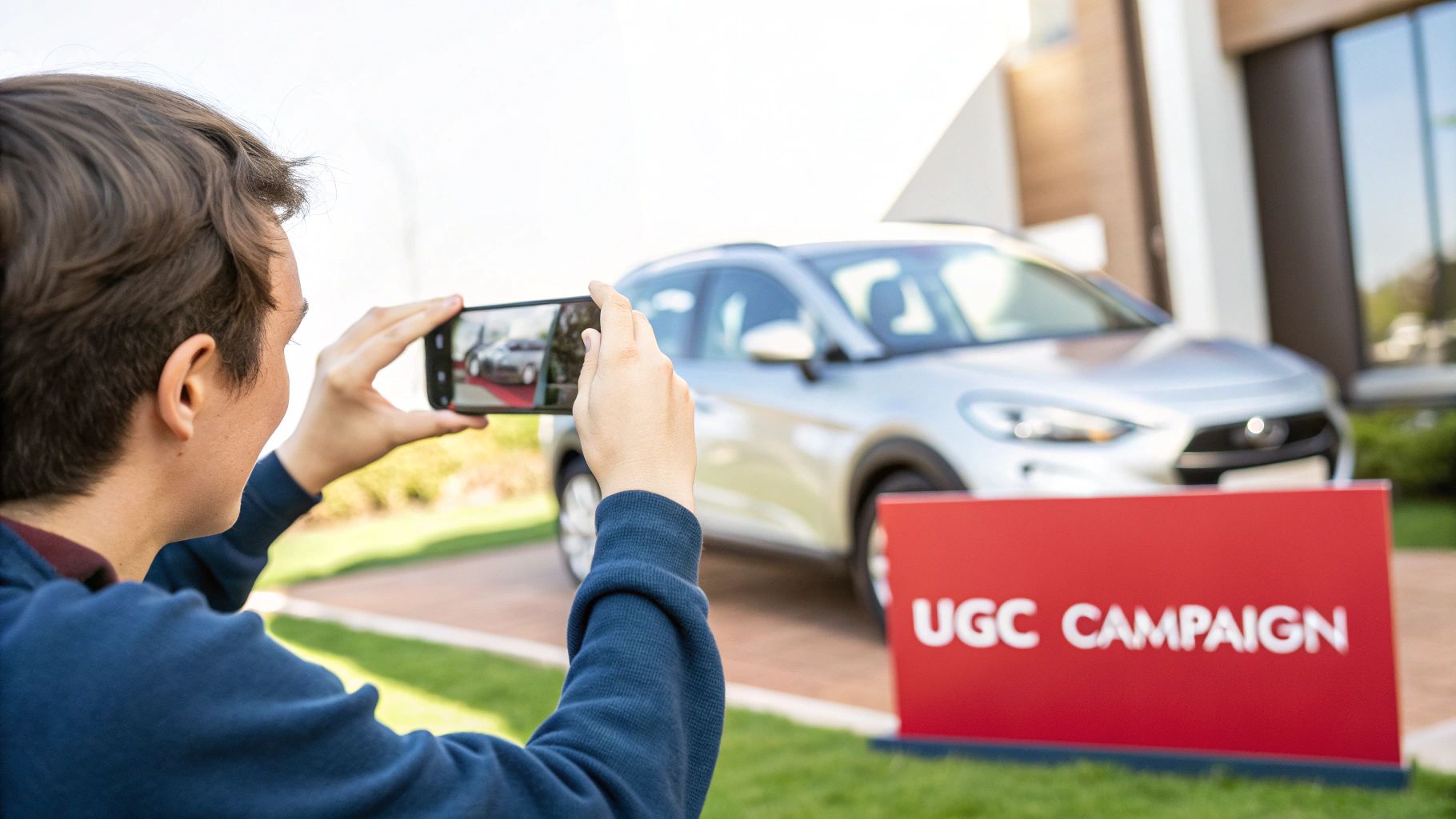
This approach provides a continuous stream of genuine, cost-effective marketing material that resonates deeply with potential buyers. When a person sees a peer showcasing their car on an adventure, it feels more trustworthy and relatable than a polished studio advertisement. Brands like Jeep have masterfully cultivated this with their long-running #JeepLife campaign, which highlights the rugged, adventurous lifestyle associated with their vehicles, all through the lens of their customers. Similarly, BMW’s #BMWRepost campaign curates and shares the best customer photography, turning their Instagram feed into a stunning, community-driven gallery.
How to Implement UGC Campaigns
To launch a successful UGC campaign, you need a clear strategy that encourages participation and protects your brand.
- Create a Memorable Hashtag: Develop a simple, unique and branded hashtag like Ford’s #FordTruckMonth. This makes it easy for you to track submissions and for users to discover related content.
- Establish Clear Guidelines: Define the type of content you are looking for and establish clear terms of use upfront. Ensure you have the right to repurpose the content by creating submission forms or terms that grant permission.
- Incentivise and Reward: Actively feature the best submissions on your social channels, website or even in digital ads. Offer rewards, such as merchandise or exclusive features, to top contributors to encourage ongoing participation.
- Engage with Every Submission: Acknowledge and respond to as many submissions as possible. This simple act of engagement makes your community feel valued and strengthens their connection to your brand. The importance of user-generated content cannot be overstated, as it builds a direct and interactive relationship with your audience. For more information, explore the importance of user-generated content in digital marketing.
2. Video Marketing and Virtual Showrooms
Video marketing has become an indispensable element of automotive social media marketing, effectively turning social media feeds into dynamic virtual showrooms. This strategy encompasses everything from detailed vehicle walkarounds and immersive test drive footage to behind-the-scenes glimpses and technology demonstrations. It directly addresses the modern consumer's preference for comprehensive digital research before ever setting foot in a physical dealership, providing a rich, engaging experience that static images cannot match.
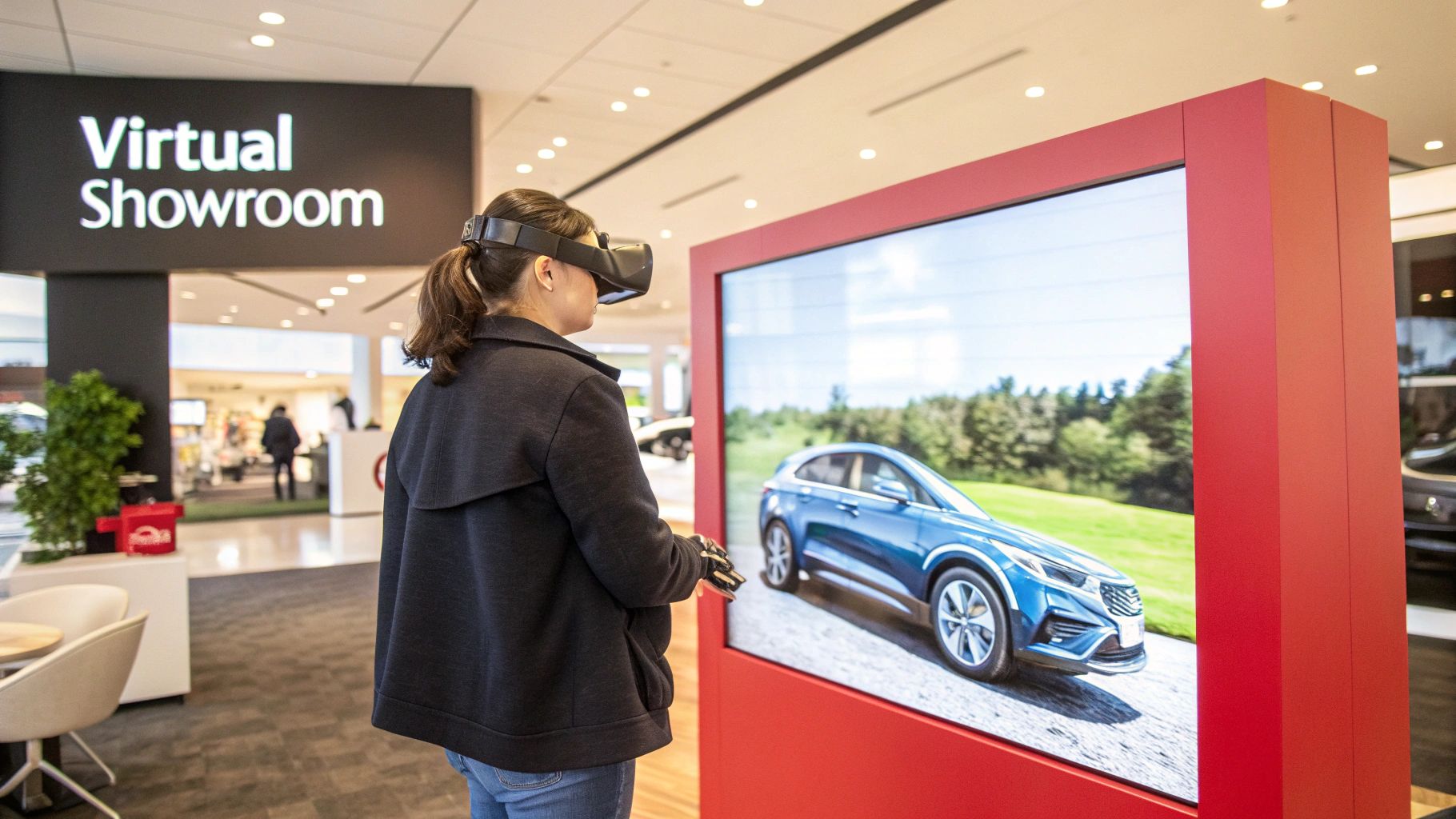
This powerful approach generates significantly higher engagement and allows potential buyers to explore a vehicle's features and feel its presence remotely. Brands like Porsche excel with cinematic brand storytelling on YouTube, while Mercedes-Benz utilises Instagram Reels to showcase the cutting-edge features of its EQ electric vehicle range. Similarly, Toyota leverages TikTok for short-form, entertaining content that captures the attention of a younger demographic, proving video's versatility across different platforms and audiences.
How to Implement Video Marketing
To transform your social channels into effective virtual showrooms, a structured video strategy is essential.
- Optimise for Attention: The first three seconds are critical. Start with a strong visual hook to capture attention and prevent users from scrolling past.
- Design for Silent Viewing: A significant portion of social media videos are watched without sound. Include clear, easy-to-read captions to ensure your message is always understood.
- Adapt Content for Each Platform: Create platform-specific versions of your videos. Use a vertical format for Instagram Stories, Reels and TikTok and a traditional horizontal format for YouTube to maximise impact. Staying current with the top short-form video trends for 2025 is crucial for keeping content fresh and relevant.
- Showcase Authenticity: Feature real customers and employees to build trust and relatability. Showcasing vehicles in real-world scenarios helps potential buyers visualise themselves using the product. The power of video marketing is undeniable, as it forges a stronger emotional connection with viewers. Discover more about the power of video marketing in the digital age.
3. Influencer and Brand Ambassador Partnerships
Influencer and brand ambassador partnerships are a powerful tool in automotive social media marketing, allowing brands to tap into the established trust and reach of social media creators. This strategy involves collaborating with automotive enthusiasts, lifestyle creators and local personalities to promote vehicles and dealership services. By leveraging an influencer's credibility, a brand’s message is transformed from a traditional advertisement into a genuine recommendation from a respected source, which resonates more effectively with their dedicated followers.
This approach offers an authentic way to showcase a vehicle’s features in real-world scenarios that align with specific lifestyles. For instance, Range Rover partners with luxury travel influencers to highlight its vehicles' blend of opulence and adventure while Mini Cooper collaborates with urban design creators to reinforce its image as a stylish city car. Similarly, Rivian has built significant momentum by working with environmental and tech influencers who can speak authentically about the benefits of electric vehicle innovation. These partnerships grant brands access to highly targeted and engaged audiences, driving brand awareness and consideration.
How to Implement Influencer Partnerships
To launch an effective influencer partnership, a strategic approach is required to ensure alignment, authenticity and a measurable return on investment.
- Prioritise Engagement Over Follower Count: Select influencers based on their audience engagement rate rather than just their follower numbers. A smaller, more dedicated community often yields better results than a large, passive one.
- Verify Audience Authenticity: Use tools to analyse an influencer's followers and ensure their audience is genuine and matches your target customer demographic. This prevents wasted investment in accounts with fake or unengaged followers.
- Grant Creative Freedom with Clear Guidelines: Provide influencers with a clear brief and brand guidelines but allow them the creative freedom to produce content that feels natural to their style. This authenticity is key to successful automotive social media marketing.
- Build Long-Term Relationships: Focus on creating long-term brand ambassador programmes instead of one-off sponsored posts. Sustained partnerships build deeper trust with the audience and deliver more consistent results. To delve deeper into this, discover more about unlocking the potential of influencer marketing strategies for success.
4. Social Commerce and Lead Generation
Social commerce transforms social media platforms from brand-building tools into direct lead generation and sales facilitation channels. This strategy integrates features like shoppable posts, lead capture forms and appointment scheduling directly within platforms such as Instagram and Facebook. Instead of just driving traffic to an external website, this approach meets customers where they are already active, reducing friction in the buyer journey and capitalising on moments of high engagement.
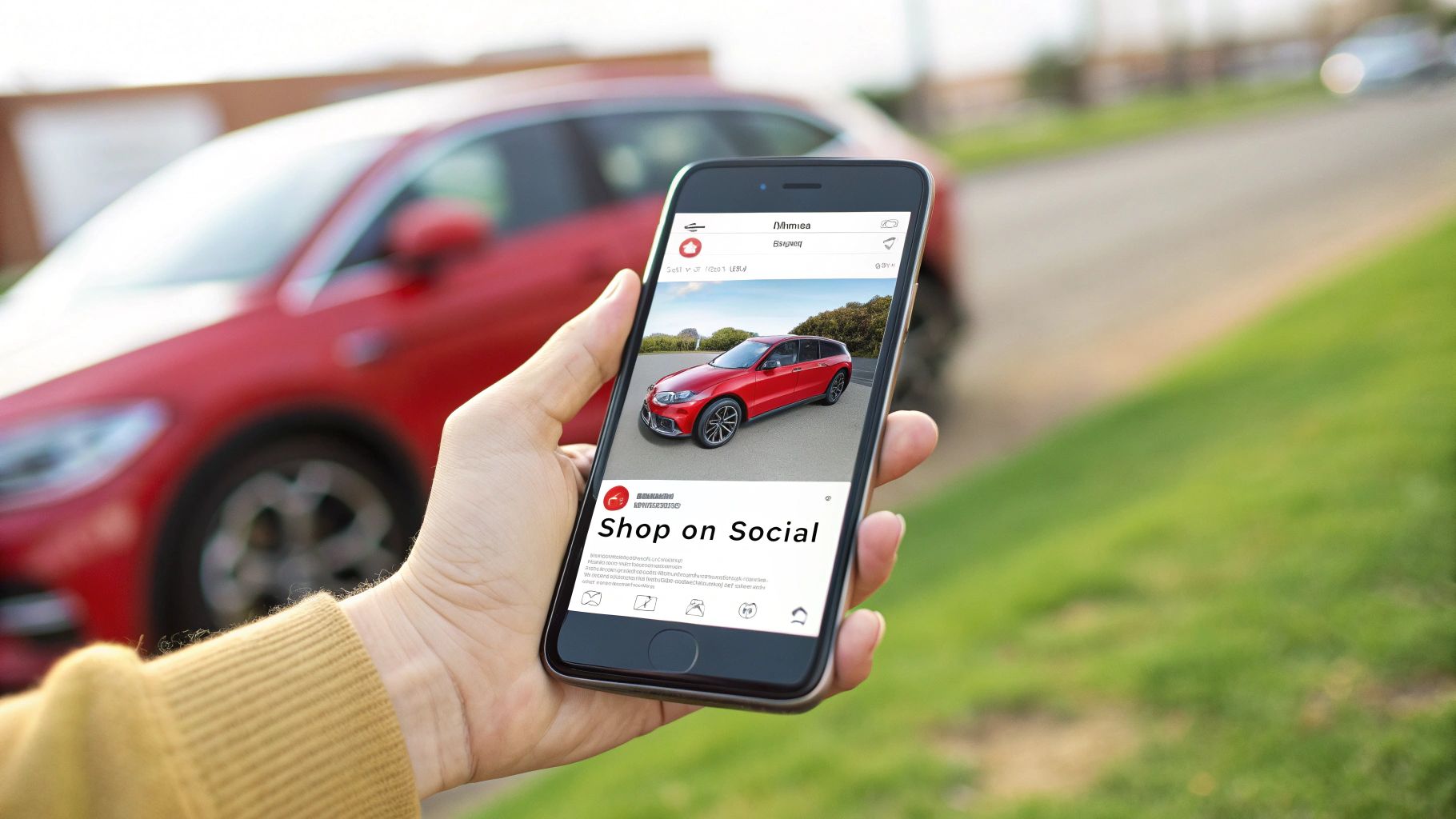
This method is a core part of effective automotive social media marketing because it shortens the path from discovery to action. Brands like Hyundai have utilised Facebook Marketplace for in-platform vehicle shopping while local dealerships often use Facebook Lead Ads to generate enquiries at a significantly lower cost per lead than website forms. Similarly, Mercedes-Benz has integrated a 'Book Test Drive' swipe-up feature in its Instagram Stories, making it effortless for interested followers to take the next step. This direct integration is crucial for converting social media engagement into measurable business outcomes.
How to Implement Social Commerce and Lead Generation
To effectively turn your social channels into lead-generating machines, you need a focused and responsive strategy.
- Optimise Lead Forms: Keep lead forms as short as possible, ideally 3-5 fields maximum, to increase completion rates. Use pre-filled form fields leveraging user data from the platform to simplify the process.
- Prioritise Rapid Response: Aim to respond to all social media leads within five minutes. This speed can result in a nine times higher likelihood of conversion. Implement automated follow-up sequences to engage leads captured outside of business hours.
- Curate Platform-Specific Showcases: Instead of uploading your entire inventory, create curated showcases tailored to the platform and audience. For example, use Instagram Shops to feature certified pre-owned vehicles or highlight special offers.
- Integrate and A/B Test: Ensure your social platform data is integrated with your CRM for a unified view of the customer journey. Continuously A/B test different calls to action, such as booking a test drive, requesting a vehicle valuation or applying for financing, to discover what performs best.
5. Community Building and Enthusiast Groups
Community building is a powerful automotive social media marketing strategy that transforms passive followers into a loyal, engaged enthusiast base. It involves creating dedicated online spaces, like Facebook Groups or forums, where owners and fans can connect, share experiences and discuss their passion for your brand. This approach cultivates a sense of belonging and turns customers into powerful brand advocates who provide peer-to-peer support and generate authentic, ongoing conversations.
By nurturing these communities, brands gain invaluable customer insights and foster an emotional connection that transcends the typical transactional relationship. Subaru has excelled with its #SubaruLove community, celebrating a shared lifestyle of adventure and loyalty. Similarly, the organic growth of Tesla owner groups and forums, often without official brand involvement, demonstrates the immense power of peer support and shared enthusiasm in building a resilient brand identity. This strategy provides a direct line to your most passionate audience, creating a self-sustaining ecosystem of engagement and advocacy.
How to Implement Community Building
Launching and managing a thriving brand community requires a delicate balance of brand presence and genuine member engagement.
- Establish Clear Guidelines: Create and consistently enforce a clear set of community rules regarding conduct, content and promotion. This ensures the space remains a positive and valuable resource for all members.
- Provide Genuine Value: Follow the 80/20 rule. Eighty percent of your content should provide value, like technical tips, member spotlights or exclusive news, while only twenty percent should be promotional.
- Empower Community Managers: Assign dedicated community managers to actively participate in discussions, answer questions and foster a welcoming atmosphere. Their role is crucial for maintaining momentum and engagement.
- Organise Exclusive Events: Strengthen online bonds with real-world connections. Organise exclusive community meetups, track days or dealership-hosted service clinics to reward members and deepen their brand loyalty. For further ideas on leveraging your audience, consider how building an audience can drive business growth.
6. Paid Social Advertising with Advanced Targeting
Paid social advertising with advanced targeting is an indispensable component of modern automotive social media marketing, allowing brands to move beyond broad-stroke promotions and reach in-market buyers with precision. This strategy involves using sophisticated tools on platforms like Meta and YouTube to deliver bespoke adverts to users based on demographic, behavioural and intent-based data. By doing so, you can connect with potential customers at every stage of their buying journey, from initial awareness to the final decision.

This method transforms advertising from a speculative expense into a calculated investment with measurable returns. It goes far beyond simple age and location targeting by leveraging lookalike audiences, retargeting website visitors and using AI-powered optimisation to maximise ROI. For example, Toyota successfully used Facebook carousel ads to showcase multiple vehicle trim levels, resulting in a 35% lower cost per lead. Similarly, Ford’s dynamic inventory ads automatically promote available F-150 stock to relevant local audiences, ensuring ad spend is always focused on vehicles ready for sale. These campaigns prove that a data-driven approach is key to cutting through the digital noise.
How to Implement Advanced Paid Social Advertising
To execute an effective paid social campaign, a structured and data-centric approach is essential for maximising your budget and achieving conversion goals.
- Structure Campaigns by Funnel Stage: Organise your campaigns into awareness, consideration and decision stages. Use distinct messaging and creative for each, such as brand-focused videos for awareness and specific model offers for decision-makers.
- Leverage High-Engagement Creative: Prioritise video content, which typically generates significantly higher engagement than static images. Use short, compelling clips for platforms like Instagram Stories and more detailed walk-arounds for YouTube.
- Implement Robust Tracking: Set up the Meta Conversion API and other server-side tracking methods to maintain data accuracy in a post-iOS 14 world. This ensures your performance metrics are reliable for optimisation.
- Refine Audience Targeting: Use audience exclusions to prevent showing adverts to existing customers for new vehicle sales. Create lookalike audiences from your best customers to find new, high-intent prospects.
- Test and Optimise Continuously: A/B test a minimum of three to five creative variations and ad copies for each audience segment. Use platform tools to automatically allocate budget to the top-performing combinations for maximum efficiency.
7. Real-Time Engagement and Social Customer Service
Real-Time Engagement and Social Customer Service transforms your social media platforms from broadcast channels into primary customer communication hubs. This strategy acknowledges that modern consumers expect immediate and helpful responses on the platforms where they initiate contact. Effective social customer service combines speed, personalisation and problem-solving to convert simple inquiries into sales and turn customer complaints into opportunities to build loyalty.
This approach treats social media as the new front line for customer support, demanding a proactive and responsive presence. When a potential buyer asks a question about a vehicle's features on your Facebook page or a current owner tweets a service concern, a swift and effective reply can significantly impact brand perception. Brands like Mercedes-Benz excel at this, with customer assistance centres often responding to Twitter inquiries within 30 minutes, directly addressing issues and reinforcing the premium nature of their brand experience.
How to Implement Real-Time Engagement
To effectively manage social customer service, you need a structured process that empowers your team to act quickly and efficiently. This is a crucial element of modern automotive social media marketing.
- Establish Response Time Targets: Set clear internal goals, such as responding in under one hour during business hours and under four hours after hours. This ensures consistency and meets customer expectations.
- Create Adaptable Templates: Develop templates for common questions about service appointments or vehicle availability but empower your team to personalise them. This maintains efficiency without sacrificing a human touch.
- Empower Your Team: Give your social media team the authority to resolve common issues without navigating complex approval chains. This autonomy is key to providing rapid solutions.
- Monitor and Prioritise: Use social listening and sentiment monitoring tools to identify urgent or escalating situations. This allows you to prioritise negative feedback and address potential crises before they grow.
- Know When to Go Private: Acknowledge issues publicly to show you are responsive but move sensitive conversations involving personal information to a private channel like Direct Messages to protect customer privacy.
- Integrate with Your CRM: Connect your social media management tool with your Customer Relationship Management (CRM) system. This provides a complete view of each customer's history and enables more informed and personalised support.
8. Educational Content and Thought Leadership
Establishing your brand as a trusted advisor is a powerful automotive social media marketing strategy that shifts the focus from selling to educating. Educational content and thought leadership involve providing genuine value to your audience by helping them make informed decisions. This approach builds authority and nurtures trust long before a customer is ready to buy, positioning your brand as the go-to resource for expert advice.
This strategy moves beyond purely promotional posts to deliver practical insights through content like vehicle comparisons, detailed buying guides, maintenance tips and explanations of new technology. When a potential buyer finds your content helpful, they develop a positive association with your brand. Volvo has excelled at this with its educational series on electric vehicles, demystifying EV ownership for curious consumers. Similarly, Subaru consistently educates its audience on the benefits of its all-wheel-drive systems, differentiating its technology from competitors in a clear and helpful way.
How to Implement Educational Content
To become a thought leader, you must consistently produce high-quality, valuable content that answers your audience's most pressing questions.
- Address Real Customer Questions: Collaborate with your sales and service teams to identify common customer queries and concerns. Use these insights to create content that directly addresses their needs, such as blog posts on seasonal vehicle preparation or videos explaining hybrid technology.
- Use Simple and Accessible Language: Avoid overly technical jargon. The goal is to make complex topics understandable for the average consumer. Use visual aids like infographics, diagrams and comparison charts to simplify information.
- Repurpose Content for Multiple Platforms: A comprehensive blog post can be transformed into a series of short videos for TikTok, a carousel for Instagram and an infographic for Pinterest. This maximises the reach and impact of your core educational material.
- Feature Your Experts: Showcase the knowledge of your technicians, salespeople and managers. Featuring real employees adds a layer of authenticity and humanises your brand, making the advice feel more personal and trustworthy. This is a key part of effective automotive social media marketing .
8 Key Strategies Comparison Guide
| Strategy | Implementation Complexity 🔄 | Resource Requirements ⚡ | Expected Outcomes 📊 | Ideal Use Cases 💡 | Key Advantages ⭐ |
|---|---|---|---|---|---|
| User-Generated Content (UGC) Campaigns | Medium; requires moderation & legal frameworks | Low; relies on community participation | Increased engagement; authentic social proof | Building trust and community engagement | Cost-effective; authentic content; emotional connection |
| Video Marketing and Virtual Showrooms | High; needs production & editing skills | High; specialized equipment & ongoing content | High engagement; better product understanding | Showcasing vehicles remotely; enhancing lead quality | High shareability; storytelling; rich demonstrations |
| Influencer and Brand Ambassador Partnerships | Medium-High; managing multi-tier partnerships | Medium-High; influencer fees vary widely | Expanded reach; authentic promotion | Targeted niche audiences; expanding brand credibility | High trust; measurable ROI; diverse content |
| Social Commerce and Lead Generation | Medium-High; technical integration across platforms | Medium; CRM and platform setup needed | Higher conversion rates; reduced purchase friction | Direct sales and lead capture on social platforms | Seamless buying process; impulse engagement; high conversion |
| Community Building and Enthusiast Groups | Medium; ongoing moderation & management | Medium; community managers & engagement effort | Strong loyalty; organic engagement; customer insights | Long-term brand loyalty; peer support & advocacy | Cost-effective; emotional bonds; continuous organic content |
| Paid Social Advertising with Advanced Targeting | High; requires expertise and ongoing optimization | High; budget and specialist skills required | Immediate traffic and leads; scalable ROI | Fast lead generation; precise audience targeting | Precise targeting; clear ROI; platform AI optimization |
| Real-Time Engagement and Social Customer Service | Medium; staffing and rapid response processes | Medium-High; dedicated service teams and tools | Higher customer satisfaction; sales conversion | Customer service on social media; complaint resolution | Builds reputation; real-time problem solving; transparency |
| Educational Content and Thought Leadership | Medium-High; content research and expertise | Medium; skilled content creators and consistent output | Brand authority; long-term organic traffic growth | Early buyer education; brand positioning as advisor | Builds trust; evergreen content; supports sales process |
Crossing the Finish Line: Implementing Your Winning Strategy
The chequered flag is waving but the race for digital dominance is far from over. We have navigated the high-speed corners of User-Generated Content, explored the technical precision of paid advertising and harnessed the raw power of video marketing. The strategies outlined are not isolated tactics to be deployed randomly but are interconnected components of a high-performance automotive social media marketing engine. Your journey from the pit lane to the podium depends on orchestrating these elements into a cohesive, powerful and authentic brand presence.
The key to success is not in attempting to implement every single strategy at once. Instead, the most effective approach is to start with a focused, strategic selection. Begin by auditing your current resources, identifying your primary business objectives and deeply understanding your target audience's behaviour online. Which platforms do they frequent? What content format resonates most? Answering these questions will illuminate the path forward.
Your Immediate Next Steps
To translate theory into traction, consider this actionable roadmap:
- Select Your Power Trio: Choose two or three strategies from this guide that align best with your immediate goals. A new dealership might prioritise virtual showrooms and local community building while a motorsport team could focus on influencer partnerships and real-time race day engagement.
- Establish Key Metrics: Define what success looks like before you start. Is it lead generation, website traffic, engagement rate or brand sentiment? Set clear, measurable Key Performance Indicators (KPIs) for each chosen strategy.
- Commit to Consistency: Social media success is a marathon not a sprint. Consistency in posting frequency, brand voice and visual identity builds trust and keeps your audience engaged. A sporadic, disjointed effort will stall your momentum before you even complete the first lap.
Ultimately, mastering automotive social media marketing is about more than just selling cars or promoting a race team; it is about building a tribe. It is about creating a space where enthusiasts, customers and fans feel seen, heard and valued. By leveraging UGC, you empower your audience to become your storytellers. By providing exceptional social customer service, you transform buyers into loyal advocates. Every authentic interaction, every piece of valuable content and every well-managed community group adds fuel to your brand's growth. The digital landscape is constantly evolving but a strategy built on authenticity, value and genuine connection will always cross the finish line in first place.
Ready to put your brand in pole position but need an expert pit crew? Superhub is a specialist automotive and motorsport marketing agency dedicated to crafting bespoke, data-driven social media strategies that deliver measurable results. Visit Superhub to see how we can help you accelerate your growth and leave the competition in your rear-view mirror.


